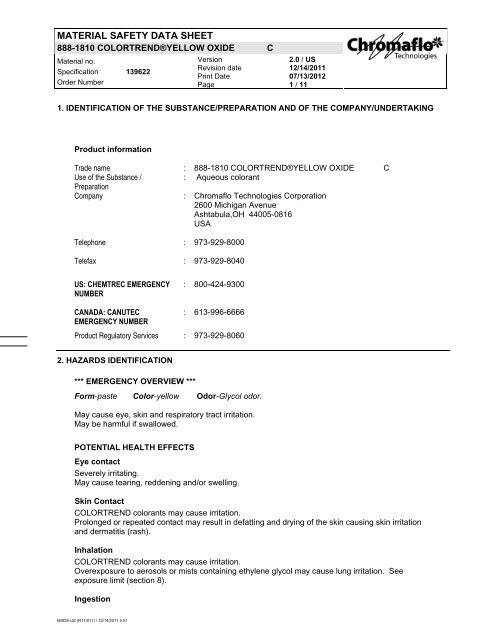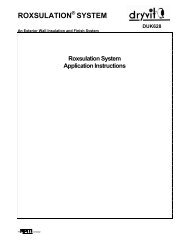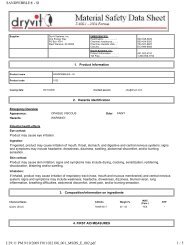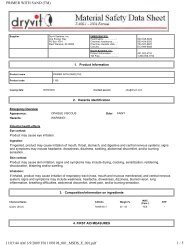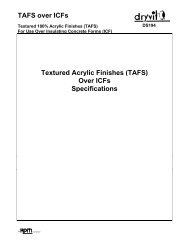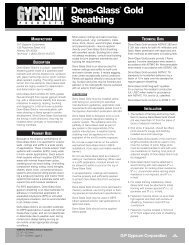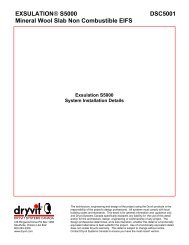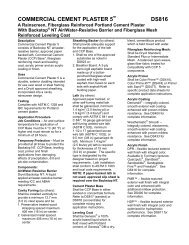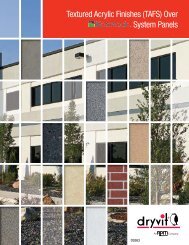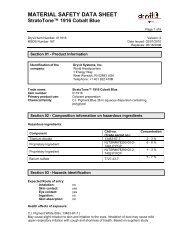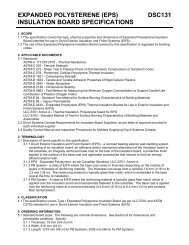Chromaflo MSDS888-1810 - Yellow Oxide C - Dryvit
Chromaflo MSDS888-1810 - Yellow Oxide C - Dryvit
Chromaflo MSDS888-1810 - Yellow Oxide C - Dryvit
Create successful ePaper yourself
Turn your PDF publications into a flip-book with our unique Google optimized e-Paper software.
MATERIAL SAFETY DATA SHEET888-<strong>1810</strong> COLORTREND®YELLOW OXIDE CMaterial no.Specification 139622Order NumberVersion2.0 / USRevision date 12/14/2011Print Date 07/13/2012Page 1 / 111. IDENTIFICATION OF THE SUBSTANCE/PREPARATION AND OF THE COMPANY/UNDERTAKINGProduct informationTrade name : 888-<strong>1810</strong> COLORTREND®YELLOW OXIDE CUse of the Substance /: Aqueous colorantPreparationCompany : <strong>Chromaflo</strong> Technologies Corporation2600 Michigan AvenueAshtabula,OH 44005-0816USATelephone : 973-929-8000Telefax : 973-929-8040US: CHEMTREC EMERGENCYNUMBER: 800-424-9300CANADA: CANUTECEMERGENCY NUMBER: 613-996-6666Product Regulatory Services : 973-929-80602. HAZARDS IDENTIFICATION*** EMERGENCY OVERVIEW ***Form-paste Color-yellow Odor-Glycol odor.May cause eye, skin and respiratory tract irritation.May be harmful if swallowed.POTENTIAL HEALTH EFFECTSEye contactSeverely irritating.May cause tearing, reddening and/or swelling.Skin ContactCOLORTREND colorants may cause irritation.Prolonged or repeated contact may result in defatting and drying of the skin causing skin irritationand dermatitis (rash).InhalationCOLORTREND colorants may cause irritation.Overexposure to aerosols or mists containing ethylene glycol may cause lung irritation. Seeexposure limit (section 8).IngestionMSDS-US (R11/011) / 12/14/2011 5:51
MATERIAL SAFETY DATA SHEET888-<strong>1810</strong> COLORTREND®YELLOW OXIDE CMaterial no.Specification 139622Order NumberVersion2.0 / USRevision date 12/14/2011Print Date 07/13/2012Page 2 / 11May be harmful if swallowed.Ingestion of ethylene glycol may cause abdominal discomfort or pain, nausea, vomiting, dizziness,drowsiness, irritability and central nervous system effects. Swallowing large volumes of ethyleneglycol causes severe kidney damage and cardiopulmonary effects (metabolic acidosis) which maybe fatal. The human oral lethal dose is approximately 1.6 g/kg.Ingestion of ethylene glycol can cause neurological impairment.Repeated ingestion of ethylene glycol can cause bone marrow, liver, and sperm effects.Ingestion of excessive amounts of diethylene glycol causes abdominal discomfort or pain, nausea,vomiting, dizziness, central nervous system effects, kidney damage and cardiopulmonary effects(metabolic acidosis) which may be fatal (estimated human oral lethal dose, 1.0 to 1.2 g/kg) andmay cause liver effects.Chronic Health HazardEthylene glycol may aggravate an existing kidney disease. Repeated skin contact with ethyleneglycol may, in a very small proportion of cases, cause sensitization with the development ofallergic contact dermatitis. The incidence is significantly less than 1% with the undiluted material.Repeated inhalation of ethylene glycol mist may produce signs of central nervous systeminvolvement, particularly dizziness and drowsiness.High concentrations of titanium dioxide dust caused microscopic lung tumors in rats in lifetimeinhalation studies. However, DuPont, the primary US manufacturer, based on a review of the testdata and based on an epidemiological study of employees, concludes that titanium dioxidepigment will not cause chronic respiratory disease in humans at concentrations experienced in theworkplace.Because this product is a free-flowing liquid or paste, dust inhalation is not an expected route ofexposure.3. COMPOSITION/INFORMATION ON INGREDIENTSInformation on ingredients / Hazardous componentsethanediol; ethylene glycolCAS-No. 107-21-1 Percent (Wt./ Wt.) 10 - 30 %NJTSR No.56705700001-5043PCAS-No. Trade Secret Percent (Wt./ Wt.) 5 - 10 %Diethylene glycolCAS-No. 111-46-6 Percent (Wt./ Wt.) 1 - 5 %Titanium dioxideCAS-No. 13463-67-7 Percent (Wt./ Wt.) 1 - 5 %Distillates (petroleum), solvent-refined heavy paraffinic; Baseoil - unspecifiedCAS-No. 64741-88-4 Percent (Wt./ Wt.) 0.1 - 1 %Distillates (petroleum), solvent-refined light paraffinic; Baseoil - unspecifiedCAS-No. 64741-89-5 Percent (Wt./ Wt.) 0.1 - 1 %Other informationThis material is classified as hazardous under OSHA regulations.MSDS-US (R11/011) / 12/14/2011 5:51
MATERIAL SAFETY DATA SHEET888-<strong>1810</strong> COLORTREND®YELLOW OXIDE CMaterial no.Specification 139622Order NumberVersion2.0 / USRevision date 12/14/2011Print Date 07/13/2012Page 3 / 114. FIRST AID MEASURESInhalationIf inhaled, remove to fresh air. If breathing is difficult, give oxygen. If unconscious, evaluate the need forartificial respiration. Get immediate medical attention.Skin contactImmediately flush skin with plenty of water for at least 15 minutes while removing contaminated clothingand shoes. Obtain medical attention. Wash clothing before reuse. Destroy or thoroughly cleancontaminated shoes before reuse.Eye contactHold eyelids apart and flush eyes with plenty of water for at least 15 minutes. Get medical attention.Do not allow contaminated water to contact the unaffected eye or face during irrigation of an affectedeye.IngestionDo not induce vomiting. If vomiting occurs spontaneously, keep head below hips to prevent aspiration ofliquid into the lungs. Get medical attention.Never administer anything by mouth to an individual who rapidly losing conciousness, unconscious orconvulsing.5. FIRE-FIGHTING MEASURESFlash pointLower explosion limitUpper explosion limitAutoignition temperaturenot determinednot determinednot determinednot determinedSuitable extinguishing mediaIn case of fire, use water (flood with water), dry chemical, CO2 or "alcohol" foam.Specific hazards during fire fightingContains material that can burn in fire if contained water is evaporated by heat or fire.Further informationAs in any fire, wear self-contained positive-pressure breathing apparatus, (MSHA/NIOSH approved orequivalent) and full protective gear. Containers can build up pressure if exposed to heat (fire). Cool withwater spray.6. ACCIDENTAL RELEASE MEASURESPersonal precautionsWear personal protective equipment; see section 8.Environmental precautionsObey relevant local, state, provincial and federal laws and regulations. Do not contaminate any lakes,streams, ponds, groundwater or soil.MSDS-US (R11/011) / 12/14/2011 5:51
MATERIAL SAFETY DATA SHEET888-<strong>1810</strong> COLORTREND®YELLOW OXIDE CMaterial no.Specification 139622Order NumberVersion2.0 / USRevision date 12/14/2011Print Date 07/13/2012Page 4 / 11Methods for cleaning upVentilate area. Absorb spill with inert material and place in a chemical waste container.7. HANDLING AND STORAGEHandlingSafe handling adviceAvoid contact with eyes, skin and clothing. Use with adequate ventilation. Avoid breathing vapor or mist.Follow all MSDS/label precautions even after container is emptied because it may retain productresidues. Wash thoroughly after handling.StorageRequirements for storage areas and containersKeep in a dry, cool place.Keep container closed when not in use.Residual vapors might explode on ignition; do not apply heat, cut, drill, grind or weld on or near thiscontainer.8. EXPOSURE CONTROLS / PERSONAL PROTECTIONComponent occupational exposure guidelines• ethanediol; ethylene glycolCAS-No. 107-21-1Control parameters 100 mg/m3 Ceiling Limit Value:(ACGIH)Aerosol.40 ppm100 mg/m3Vapor.Ceiling Limit Value:(US CA OEL)• Titanium dioxideCAS-No. 13463-67-710 mg/m3 Time Weighted Average (TWA):(ACGIH)15 mg/m3 PEL:(OSHA Z1)Total dust.• Distillates (petroleum), solvent-refined heavy paraffinic; Baseoil - unspecifiedCAS-No. 64741-88-4400 ppm1600 mg/m3Listed.500 ppmPEL:(OSHA Z1)2000 mg/m35 mg/m3 PEL:(OSHA Z1)Mist.Time Weighted Average (TWA)Permissible Exposure Limit (PEL):(US CAOEL)(US CA OEL)MSDS-US (R11/011) / 12/14/2011 5:51
MATERIAL SAFETY DATA SHEET888-<strong>1810</strong> COLORTREND®YELLOW OXIDE CMaterial no.Specification 139622Order NumberVersion2.0 / USRevision date 12/14/2011Print Date 07/13/2012Page 5 / 115 mg/m3 Time Weighted Average (TWA)Permissible Exposure Limit (PEL):(US CAOEL)Mist.(ACGIH)Included in the regulation but with no data values. See regulation for further details(ACGIH)Exposure by all routes should be carefully controlled to levels as low as possible.5 mg/m3 Time Weighted Average (TWA):(ACGIH)Inhalable fraction.• Distillates (petroleum), solvent-refined light paraffinic; Baseoil - unspecifiedCAS-No. 64741-89-55 mg/m3 Time Weighted Average (TWA):(ACGIH)Mist.10 mg/m3 Short Term Exposure Limit(STEL):(ACGIH)Mist.5 mg/m3 PEL:(OSHA Z1)Mist.5 mg/m3 Time Weighted Average (TWA)Permissible Exposure Limit (PEL):(US CAOEL)Mist.(ACGIH)Included in the regulation but with no data values. See regulation for further details(ACGIH)Exposure by all routes should be carefully controlled to levels as low as possible.5 mg/m3 Time Weighted Average (TWA):(ACGIH)Inhalable fraction.Other informationThe exposure value for ethylene glycol is given as an aerosol.The AIHA WEEL for diethylene glycol is 50 PPM for total vapor and aerosol and 10 mg/m3 for aerosolalone (eight hour time-weighted averages).Engineering measuresUse only in well-ventilated areas.MSDS-US (R11/011) / 12/14/2011 5:51
MATERIAL SAFETY DATA SHEET888-<strong>1810</strong> COLORTREND®YELLOW OXIDE CMaterial no.Specification 139622Order NumberPersonal protective equipmentVersion2.0 / USRevision date 12/14/2011Print Date 07/13/2012Page 6 / 11Respiratory protectionA respiratory protection program that meets OSHA 1910.134 and ANSI Z88.2 or applicablefederal/provincial requirements must be followed whenever workplace conditions warrant respirator use.NIOSH's "Respirator Decision Logic" may be useful in determining the suitability of various types ofrespirators.Hand protectionUse impermeable gloves.Eye protectionChemical resistant goggles must be worn.Skin and body protectionA safety shower and eye wash fountain should be readily available.To identify additional Personal Protective Equipment (PPE) requirements, it is recommended that ahazard assessment in accordance with the OSHA PPE Standard (29CFR1910.132) be conducted beforeusing this product.9. PHYSICAL AND CHEMICAL PROPERTIESAppearanceFormpasteColoryellowOdorGlycol odor.Safety datapH 8.0 - 9.0Boiling point/range > 100 °CFlash pointAutoignition temperature:Lower explosion limitUpper explosion limitnot determinednot determinednot determinednot determinedRelative density 1.8Solubility/qualitativeViscosity, dynamicRelative vapor densityEvaporation rateSolubility in water: Dispersible.70 - 90 KU (25 °C)Heavier than airSlower than butyl acetate10. STABILITY AND REACTIVITYMSDS-US (R11/011) / 12/14/2011 5:51
MATERIAL SAFETY DATA SHEET888-<strong>1810</strong> COLORTREND®YELLOW OXIDE CMaterial no.Specification 139622Order NumberVersion2.0 / USRevision date 12/14/2011Print Date 07/13/2012Page 7 / 11Conditions to avoidMaterials to avoidNot applicable.strong acids, oxidizing substances, sodium hypochlorite11. TOXICOLOGICAL INFORMATIONComponent Acute oral toxicityethanediol; ethylene glycol107-21-1LD50 Rat(female): 4000 mg/kgNJTSR No.56705700001-5043PTrade SecretLD50 Rat: 3000 mg/kgDiethylene glycol111-46-6LD50 Rat: 20760 mg/kgTitanium dioxide13463-67-7LD50 Rat: > 24000 mg/kgComponent Acute inhalationtoxicityTitanium dioxide13463-67-7LC50 Rat: > 6820 mg/m3 / 4 hComponent Acute dermal toxicity ethanediol; ethylene glycol107-21-1LD50 Rabbit: 10500 mg/kgNJTSR No.56705700001-5043PTrade SecretLD50 Rabbit: 4400 mg/kgDiethylene glycol111-46-6LD50 Rabbit: 13300 mg/kgTitanium dioxide13463-67-7LD50 Rabbit: > 10000 mg/kgComponent Repeated dosetoxicityethanediol; ethylene glycol107-21-1Chronic ingestion of an ingredient in this product has been shown to causeadverse effects on the peripheral nervous system of laboratory animals.Titanium dioxide13463-67-7High concentrations of titanium dioxide dust caused microscopic lungtumors in rats in lifetime inhalation studies. However, DuPont, the primaryUS manufacturer, based on a review of the test data and based on anMSDS-US (R11/011) / 12/14/2011 5:51
MATERIAL SAFETY DATA SHEET888-<strong>1810</strong> COLORTREND®YELLOW OXIDE CMaterial no.Specification 139622Order NumberVersion2.0 / USRevision date 12/14/2011Print Date 07/13/2012Page 8 / 11epidemiological study of employees, concludes that titanium dioxidepigment will not cause chronic respiratory disease in humans atconcentrations experienced in the workplace.Component carcinogenicityassessmentComponent teratogenicityassessmentComponent General ToxicityInformationTitanium dioxide13463-67-7Contains a component which is classified as an IARC 2B carcinogen(possibly carcinogenic to humans).ethanediol; ethylene glycol107-21-1Ethylene glycol has been shown to produce dose-related teratogeniceffects in rats and mice when given by gavage or in drinking water at highconcentrations or doses. However, there is currently no availableinformation to suggest that ethylene glycol has caused birth defects inhumans.ethanediol; ethylene glycol107-21-1Ethylene glycol may aggravate an existing kidney disease. Repeated skincontact with ethylene glycol may, in a very small proportion of cases, causesensitization with the development of allergic contact dermatitis. Theincidence is significantly less than 1% with the undiluted material.Repeated inhalation of ethylene glycol mist may produce signs of centralnervous system involvement, particularly dizziness and drowsiness.Diethylene glycol111-46-6According to long-term animal inhalation studies, very high concentrationsof diethylene glycol vapors caused central nervous system effects in miceand rats. However, an extensive review of the literature shows that nosuch effects have been documented in humans (Patty's Industrial Hygieneand Toxicology, 1982, Third Revised Ed., Vol 2c, p 3838).In a continuous breeding study of mice, continued ingestion of largeamounts of diethylene glycol (6 g/kg/day) caused an adverse effect onfertility and some embryotoxic and fetotoxic effects concurrent with somematernal toxicity. The relevance of these very high doses to humans isuncertain.12. ECOLOGICAL INFORMATIONGeneral Ecological InformationNo ecotoxicological studies are available.13. DISPOSAL CONSIDERATIONSWASTE DISPOSALAdvice on disposalWaste must be disposed of in accordance with federal, state, provincialand local regulations. CONTAINER DISPOSAL: Empty containers byremoving the top and inverting to allow all free-flowing product to drain. ToMSDS-US (R11/011) / 12/14/2011 5:51
MATERIAL SAFETY DATA SHEET888-<strong>1810</strong> COLORTREND®YELLOW OXIDE CMaterial no.Specification 139622Order NumberVersion2.0 / USRevision date 12/14/2011Print Date 07/13/2012Page 9 / 11meet regulatory criteria, the container is considered empty when less than3% remains in the container. Additional special handling is not typicallyrequired and the empty container can be discarded with other nonhazardoustrash. Note: Local disposal regulations may be more stringentand require additional restrictions or precautions. Customers shouldcheck with their local disposal company, municipal or state authority.Recycle of plastic or metal containers may require clean rather than emptycontainers. In this case the containers can be rinsed with water until thecontainers are considered generally product free.14. TRANSPORT INFORMATIOND.O.T. Road/RailClass 9UN-No 3082Packing groupIIIProper shipping nameEnvironmentally hazardous substance, liquid, n.o.s.Loading instructions/RemarksIATA_CNot dangerous according to transport regulations.IATA_PNot dangerous according to transport regulations.IMDGNot dangerous according to transport regulations.CFR_INWTRUSA: Not regulated for transport when package contains less than thereportable quantity listed in section 15 of the msds.CFR_RAILUSA: Not regulated for transport when package contains less than thereportable quantity listed in section 15 of the msds.CFR_ROADUSA: Not regulated for transport when package contains less than thereportable quantity listed in section 15 of the msds.15. REGULATORY INFORMATIONUS Federal RegulationsOSHAIf listed below, chemical specific standards apply to the product or components:• None listedClean Air Act Section (112)If listed below, components present at or above the de minimus level are hazardous air pollutants:• ethanediol; ethylene glycolCAS-No. 107-21-1CERCLA Reportable QuantitiesIf listed below, a reportable quantity (RQ) applies to the product based on the percent of the namedcomponent:MSDS-US (R11/011) / 12/14/2011 5:51
MATERIAL SAFETY DATA SHEET888-<strong>1810</strong> COLORTREND®YELLOW OXIDE CMaterial no.Specification 139622Order Number• ethanediol; ethylene glycolCAS-No. 107-21-1Reportable Quantity 25604 lbsVersion2.0 / USRevision date 12/14/2011Print Date 07/13/2012Page 10 / 11SARA Title III Section 311/312 Hazard CategoriesThe product meets the criteria only for the listed hazard classes:• Acute Health Hazard• Chronic Health HazardSARA Title III Section 313 Reportable SubstancesIf listed below, components are subject to the reporting requirements of Section 313 of Title III of theSuperfund Amendments and Reauthorization Act of 1986 and 40 CFR Part 372:• ethanediol; ethylene glycolCAS-No. 107-21-1Toxic Substances Control Act (TSCA)If listed below, non-proprietary substances are subject to export notification under Section 12 (b) ofTSCA:• None listedState RegulationsCalifornia Proposition 65A warning under the California Drinking Water Act is required only if listed below:• None listedMSDS-US (R11/011) / 12/14/2011 5:51
MATERIAL SAFETY DATA SHEET888-<strong>1810</strong> COLORTREND®YELLOW OXIDE CMaterial no.Specification 139622Order NumberInternational Chemical Inventory StatusVersion2.0 / USRevision date 12/14/2011Print Date 07/13/2012Page 11 / 11Unless otherwise noted, this product is in compliance with the inventory listing of the countries shownbelow. For information on listing for countries not shown, contact the Product Regulatory ServicesDepartment.• Europe (EINECS/ELINCS) Listed/registered• USA (TSCA) Listed/registered• Canada (DSL) Listed/registered• Australia (AICS) Listed/registered• Japan (MITI) Not listed/Not registered• Korea (TCCL) Listed/registered• Philippines (PICCS) Listed/registered• China Listed/registered• New Zealand Listed/registered16. OTHER INFORMATIONHMIS RatingsHealth : 2*Flammability : 1Physical Hazard : 0Further informationChanges since the last version are highlighted in the margin. This version replaces all previous versions.The information provided in this Safety Data Sheet is correct to the best of our knowledge, informationand belief at the date of its publication. The information given is designed only as a guidance for safehandling, use, processing, storage, transportation, disposal and release and is not to be considered awarranty or quality specification. The information relates only to the specific material designated andmay not be valid for such material used in combination with any other materials or in any process, unlessspecified in the text.MSDS-US (R11/011) / 12/14/2011 5:51


